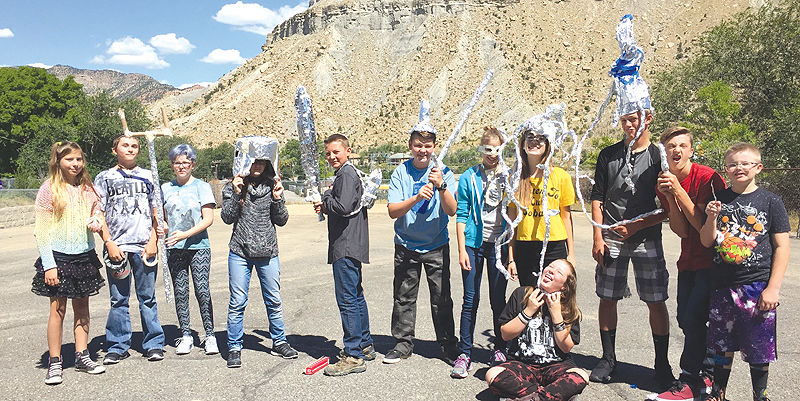Helper Middle School’s SAGE scores have outpaced many of the schools in the state.
“They compare us to schools of similar size and similar demographics when they compile our growth and proficiency on tests,” said Helper Middle School Principal Mika Salas. “Since 2014, our place in that group of schools has risen a great deal, and we are very excited about it.”
SAGE (Student Assessment of Growth and Excellence) tests demonstrate if the student is proficient in a subject, and also show the growth that a student has achieved from past years. These scores are all taken into account when schools are examined for their effectiveness.
Schools are measured against other similar schools. In the case of Helper it is judged against 20 other schools that are similar in size and type.
In proficiency, Helper has shown great progress in all three subject areas, language arts, mathematics and science.
In the language arts area of instruction in 2014 the school was third from the bottom in ranking, while last spring test scores revealed that the school has moved up to number two on the list. In terms of growth in student achievement in that same area, Helper was in the middle of the pack in 2014 while last year it moved up to number one.
‘Unbelievable achievement’
“The only school we were behind in proficiency was North Summit Middle School which has very different demographics and socioeconomic factors than we do,” said Salas. “I have to say that achievement is unbelievable.”
Similar types of numbers showed up for mathematics too. In 2014 proficiency at the school showed them to be last on the list while results from the last round of tests showed that the campus is now ranked sixth. In terms of growth in 2014, the school was at the bottom of the pile while last year it reached second place.
“To jump that much in mathematics is awesome,” said Salas. “It is so hard to raise the proficiency in math, and many people don’t understand that. If the growth continues the proficiency will keep rising.”
Science instruction and learning also took a big leap. In 2014 the school was 13th in proficiency while last year they reached third. In terms of growth the school went from a 13th place to second based on the test results.
When asked what she attributes the rise in proficiency and growth she responded by saying it is “our response to intervention.”
“We’ve worked incredibly hard on identifying which pieces of the curriculum are most important, breaking them down and then identifying the components. So instead of saying that in sixth grade students should know how to add fractions with different denominators and you set that as a goal and then some kids don’t pass the assessment, you don’t say ‘We have to move on.’ If that is an essential skill to know, and a student will need it later, we break it down into its parts. First they must know their multiplication facts, they would have to know how to find a common denominator, be able to convert the fraction to equivalent fractions, simplify those fractions and then add them. Those are separate skills, and they are really small areas. If a student is having a problems like this we have our flex time four days a week where students can go to be helped.”
Under the flex time program (a half hour each morning every day but Monday) there might be 10 students in the school that are missing one particular piece of the fraction process and so all 10 would be in a room together just to learn that that skill.
“There is no just asking ‘who needs help with fractions?’ but instead, ‘who needs help with some specific skill?’” she said. “Most importantly we do not let it go until every single student masters the concept, and every student must master those kinds of concepts regardless of who they are.”
Of course not all students need extra instruction. Salas said that every staff member in the school helps out during flex time by taking kids and working with them or giving them a place to be, should they not need extra instruction. Students that don’t need help can read, do homework or even go to the gym to do fun things. This allows teachers to have very small groups in their classrooms to help students that do need extra attention. But there is also more to seeing improvement than just teaching the skills.
“We are teaching behaviors too,” said Salas. “Last year we implemented a full tiered behavior system. Teachers don’t have individual classroom rules, but we have school-wide rules that we all follow. That way school staff are all saying the same thing.”
Reflection sheets
The system is based on reflection sheets that are issued by school staff and filled out by the student. The number of reflection sheets that a student has helps determine the path they must follow to improve.
“There is no wiggle room, there’s no guessing,” stated Salas. “Students know exactly where they are on citizenship.”
In the first few weeks of school, during flex time, students are trained on the rules, so they know what to do and what will happen if they don’t follow them. There is also an assembly in that first month as well as a reminder each day on the behavior rules during the announcements. Since the school mascot is Rams it has come to stand for Respect, Accountability, and Making a positive difference. Counselors teach skills to the students on behavior. Those skills are taught just like the academic ones; students must know and master them. The lessons are different for each grade level, geared to their levels maturity.

